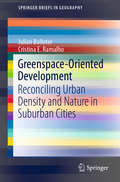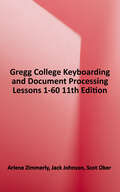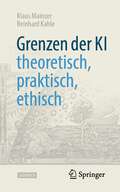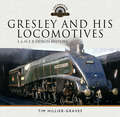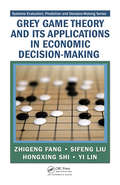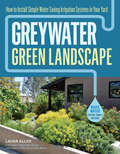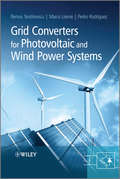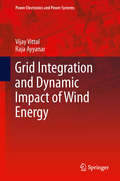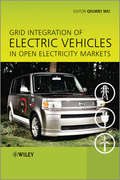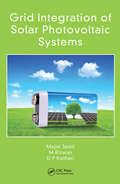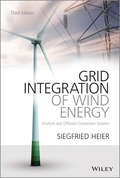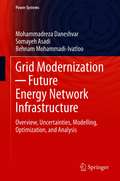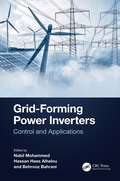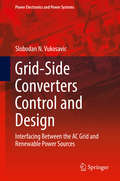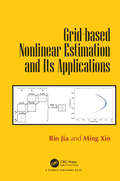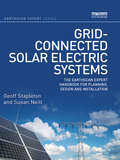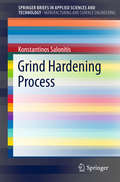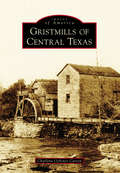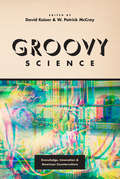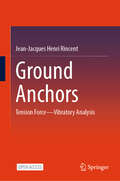- Table View
- List View
Greenspace-Oriented Development: Reconciling Urban Density and Nature in Suburban Cities (SpringerBriefs in Geography)
by Julian Bolleter Cristina E. RamalhoTransit-Oriented Development (TOD) planning principles have informed Australian city planning for over two decades. As such, policy makers and planners often unquestioningly apply its principles. In contrast, this book critiques TOD and argues that while orientating development towards public transport hubs makes some sense, the application of TOD principles in Australia has proven a significant challenge. As a complementary strategy, the book stakes out the potential of Greenspace-Oriented Development (GOD) in which urban density is correlated with upgraded green spaces with reasonable access to public transport. Concentrating urban densification around green spaces offers many advantages to residents including ecosystem services such as physical and mental health benefits, the mitigation of extreme heat events, biodiversity and clean air and water. Moreover, the open space and leafy green qualities of GOD will ensure it resonates with the lifestyle aspirations of suburban residents who may otherwise resist urban densification. We believe in this way, that GOD could be an urban dream that befits the challenges of this 21st century.
Gregg College Keyboarding & Document Processing Lessons 1-60 11th Edition
by Scot Ober Arlene Zimmerly Jack JohnsonGDP/11 is an integrated keyboarding system designed to process and score documents created in Microsoft Word. Together, this book and software systematically lead students through each lesson to provide an easy path to success.
Grenfell and Construction Industry Reform: A Guide for the Construction Professional
by Steve Phillips Jim MartinIn the wake of the tragic events of the fire at Grenfell Tower, the inquiry into the fire and the independent Hackitt Review revealed deep-rooted and unpalatable truths about the current state of the UK construction industry. Dame Judith Hackitt was scathing in her assessment of the construction industry denouncing it as "an industry that has not reflected and learned for itself, nor looked to other sectors" and defining the key issues as ignorance, indifference, lack of clarity on roles and responsibilities and inadequate regulatory oversight and enforcement tools. There is an urgent need to change practices and behaviours to prevent a similar tragedy from reoccurring. This book sets out the changes required, why they are required, how they are to be achieved and the progress towards them to date. Implementation of these major safety reforms will move the construction industry from the conditions that allowed the fire at Grenfell Tower to occur, to a system where construction professionals take greater responsibility for the safety of residents in their buildings. This book provides an overview of how the movement towards implementing a new building safety regime has unfolded over the last three years and details what still needs to be done if residents are to feel safe and be safe in their own homes.
Grenzen der KI – theoretisch, praktisch, ethisch (Technik im Fokus)
by Klaus Mainzer Reinhard KahleKünstliche Intelligenz ist eine Schlüsseltechnologie, mit der sowohl in der Wissenschaft als auch in der Industrie große Erwartungen verbunden sind. In diesem Buch werden sowohl die Perspektiven als auch die Grenzen dieser Technologie diskutiert. Das betrifft die praktischen, theoretischen und konzeptionellen Herausforderungen, denen sich die KI stellen muss. In einer Frühphase standen in der KI Expertensysteme im Vordergrund, bei denen mit Hilfe symbolischer Datenverarbeitung regelbasiertes Wissen verarbeitet wurde. Heute wird die KI von statistik-basierten Methoden im Bereich des maschinellen Lernens beherrscht. Diese subsymbolische KI wird an den Lehren, die aus der Frühphase der KI gezogen werden können, gemessen. Als Ergebnis wird vor allem für eine hybride KI argumentiert, die die Potentiale beider Ansätze zur Entfaltung bringen kann.
Gresley and His Locomotives: L & N E R Design History
by Tim Hillier-GravesAn in-depth look at the team who worked with the renowned British railway engineer, with numerous photos included.To renowned engineer Nigel Gresley must go great credit for many of the London and North Eastern Railway’s achievements, but those around him have faded into obscurity and are now largely forgotten, even though their contributions were immense. To redress this imbalance, Tim Hillier-Graves has explored the life of Gresley and his team, and sought to uncover a more expansive picture of these events. This in no way diminishes Gresley’s stunning accomplishments—but builds a fuller and more authentic view of a dynamic period in railway history.The book draws upon many sources of information, some of it previously unpublished, to present a fascinating picture of all that happened and all that was achieved, often in the most difficult of circumstances, by a very gifted team of engineers and their exceptional leader.
Gresley and His Locomotives: L & N E R Design History (Locomotive Portfolios Ser.)
by Tim Hillier-GravesAn in-depth look at the team who worked with the renowned British railway engineer, with numerous photos included.To renowned engineer Nigel Gresley must go great credit for many of the London and North Eastern Railway’s achievements, but those around him have faded into obscurity and are now largely forgotten, even though their contributions were immense. To redress this imbalance, Tim Hillier-Graves has explored the life of Gresley and his team, and sought to uncover a more expansive picture of these events. This in no way diminishes Gresley’s stunning accomplishments—but builds a fuller and more authentic view of a dynamic period in railway history.The book draws upon many sources of information, some of it previously unpublished, to present a fascinating picture of all that happened and all that was achieved, often in the most difficult of circumstances, by a very gifted team of engineers and their exceptional leader.
Grey Game Theory and Its Applications in Economic Decision-Making (Systems Evaluation, Prediction, and Decision-Making)
by Yi Lin Sifeng Liu Zhigeng Fang Hongxing ShiTo make the best decisions, you need the best information. However, because most issues in game theory are grey, nearly all recent research has been carried out using a simplified method that considers grey systems as white ones. This often results in a forecasting function that is far from satisfactory when applied to many real situations. Grey Ga
Greywater Reuse
by Amit Gross Adi Maimon Yuval Alfiya Eran FriedlerGreywater Reuse examines the features and implications of greywater reuse scientifically, quantitatively, and thoroughly. Based on the authors' extensive studies of treatment facilities in urban and rural environments, development of greywater treatment systems, and research of potential environmental and health risks posed by greywater at differen
Greywater, Green Landscape: How to Install Simple Water-Saving Irrigation Systems in Your Yard
by Laura AllenKeep your lawn and garden lush without wasting resources by capturing and recycling the greywater that drains from your sink, shower, and washing machine. This accessible and detailed guide walks you through each step of planning for and installing a variety of greywater systems, including laundry-to-landscape and branched drain gravity-fed systems. After identifying greywater sources in your home and estimating flow rate, you’ll learn to pinpoint where to redirect the wastewater for the greatest benefit. No matter which system you decide to build, you'll have the information to construct it yourself or move forward with confidence to hire a professional.
Grid Converters for Photovoltaic and Wind Power Systems
by Remus Teodorescu Pedro Rodríguez Marco LiserreGrid converters are the key player in renewable energy integration. The high penetration of renewable energy systems is calling for new more stringent grid requirements. As a consequence, the grid converters should be able to exhibit advanced functions like: dynamic control of active and reactive power, operation within a wide range of voltage and frequency, voltage ride-through capability, reactive current injection during faults, grid services support.This book explains the topologies, modulation and control of grid converters for both photovoltaic and wind power applications. In addition to power electronics, this book focuses on the specific applications in photovoltaic wind power systems where grid condition is an essential factor.With a review of the most recent grid requirements for photovoltaic and wind power systems, the book discusses these other relevant issues:modern grid inverter topologies for photovoltaic and wind turbines islanding detection methods for photovoltaic systems synchronization techniques based on second order generalized integrators (SOGI) advanced synchronization techniques with robust operation under grid unbalance condition grid filter design and active damping techniques power control under grid fault conditions, considering both positive and negative sequences Grid Converters for Photovoltaic and Wind Power Systems is intended as a coursebook for graduated students with a background in electrical engineering and also for professionals in the evolving renewable energy industry. For people from academia interested in adopting the course, a set of slides is available for download from the website. www.wiley.com/go/grid_converters
Grid Integration and Dynamic Impact of Wind Energy
by Raja Ayyanar Vijay VittalGrid Integration and Dynamic Impact of Wind Energy details the integration of wind energy resources to the electric grid worldwide. Authors Vijay Vittal and Raja Ayyanar include detailed coverage of the power converters and control used in interfacing electric machines and power converters used in wind generators, and extensive descriptions of power systems operation and control to accommodate large penetration of wind resources. Key concepts will be illustrated through extensive power electronics and power systems simulations using software like MATLAB, Simulink and PLECS. The book addresses real world problems and solutions in the area of grid integration of wind resources, and will be a valuable resource for engineers and researchers working in renewable energy and power.
Grid Integration of Electric Vehicles in Open Electricity Markets
by Qiuwei WuPresenting the policy drivers, benefits and challenges for grid integration of electric vehicles (EVs) in the open electricity market environment, this book provides a comprehensive overview of existing electricity markets and demonstrates how EVs are integrated into these different markets and power systems.Unlike other texts, this book analyses EV integration in parallel with electricity market design, showing the interaction between EVs and differing electricity markets. Future regulating power market and distribution system operator (DSO) market design is covered, with up-to-date case studies and examples to help readers carry out similar projects across the world.With in-depth analysis, this book describes:the impact of EV charging and discharging on transmission and distribution networksmarket-driven EV congestion management techniques, for example the day-ahead tariff based congestion management scenario within electric distribution networks optimal EV charging management with the fleet operator concept and smart charging managementEV battery technology, modelling and tests the use of EVs for balancing power fluctuations from renewable energy sources, looking at power system operation support, including frequency reserve, power regulation and voltage supportAn accessible technical book for power engineers and grid/distributed systems operators, this also serves as a reference text for researchers in the area of EVs and power systems. It provides distribution companies with the knowledge they need when facing the challenges introduced by large scale EV deployment, and demonstrates how transmission system operators (TSOs) can develop the existing system service market in order to fully utilize the potential of EV flexibility. With thorough coverage of the technologies for EV integration, this volume is informative for research professors and graduate students in power systems; it will also appeal to EV manufacturers, regulators, EV market professionals, energy providers and traders, mobility providers, EV charging station companies, and policy makers.
Grid Integration of Solar Photovoltaic Systems
by Majid Jamil M Rizwan D P KothariThis book covers the various aspects of solar photovoltaic systems including measurement of solar irradiance, solar photovoltaic modules, arrays with MATLAB implementation, recent MPPT techniques, latest literature of converter design (with MATLAB Simulink models), energy storage for PV applications, balance of systems, grid integration of PV systems, PV system protection, economics of grid connected PV system and system yield performance using PV system. Challenges, issues and solutions related to grid integration of solar photovoltaic systems are also be dealt with.
Grid Integration of Wind Energy
by Siegfried HeierThis timely update provides detailed treatment of the integration of wind power into electrical power systems, including brand new material on offshore wind power farms and technologiesThis third English edition is based on new material from the fourth and fifth German editions (Windkraftanlagen: Systemauslegung, Netzintegration und Regelung, 5. Auflage, published by Teubner B.G. Gmbh, July 2009). It answers the question of how, with the proper control and direction, wind turbines can be made to operate more similarly to conventional power plants. The revised third edition addresses the engineering challenges of cost effective transmission and distribution of wind power, such as technical, economic and safety issues. It also incorporates all the recent technical developments in electrical power conversion systems and essential operating conditions, and includes unique, original research findings carried out by the author's own PhD and Masters students at Kassel University, Germany.This popular reference book has been updated to include new material from the fourth and fifth German editions, equating to 12.5% brand new materialNew material covers the 'hot topic' of grid connection for offshore wind farms and offshore technologies, including lots of illustrationsBrand new material on low voltage fault dynamics and control of turbinesIncludes up-to-date coverage on completely new generator developments for wind turbines, developed over the past two yearsIllustrates how wind turbines can operate like conventional power plants using advanced control systems.Discusses the profitability of wind turbine integration in electrical power grids, and the environmental impact
Grid Modernization ─ Future Energy Network Infrastructure: Overview, Uncertainties, Modelling, Optimization, and Analysis (Power Systems)
by Behnam Mohammadi-Ivatloo Somayeh Asadi Mohammadreza DaneshvarThis book presents theoretical, technical, and practical information on the modernization of future energy networks. All the basic requirements covering concepts, modeling, optimizing, and analyzing of future energy grids with various energy carriers such as electricity, gas, heat, and water, as well as their markets and contracts, are explained in detail. The main focus of the book is on modernizing both the energy consumers and the energy producers and analyzing various aspects of grid modernization such as reliability, resiliency, stability, and security. Coverage includes advanced communication protocols and solution methods for the Internet of Energy (IoE) infrastructure and energy trading in future energy grids with high/full share of renewable energy resources (RERs) within the transactive energy (TE) paradigm. Probabilistic modeling and optimizing of modern grids will be evaluated using realistic case studies considering the economic aspects of multi-carrier energy markets. This book will be welcomed as an important resource by researchers and postgraduate students studying energy systems, as well as practicing engineers working on modernizing energy grids and the design, planning, scheduling, and operation of smart power systems.Proposes practical solutions for solving the challenges of modern multi-carrier energy grids;Examines various types of energy storage systems and distributed energy resources (DERs) with an emphasis on renewable energy resources (RERs);Provides comprehensive mathematical models for optimizing of future modern multi-carrier energy grids.
Grid-Connected Photovoltaic Power Generation
by Peter GevorkianCovering technical design and construction aspects as well as financial analysis and risk assessment, this professional reference work provides a comprehensive overview of solar power technology. Whether or not you have a technology background, this essential guide will help you to understand the design, construction, financial analysis, and risk assessment of solar power technology. The first two chapters present an uncomplicated overview of solar power technology physics, solar cell technology, applications, and equipment. In subsequent chapters, readers are introduced to fundamental econometric analysis in such a way that will allow anyone, whether or not they have a background in finance, to become familiar with the fundamental costing and financing of large scale solar power programs. This book is essential reading for anyone involved with solar power project development, and is suitable for both graduate students and professionals.
Grid-Forming Power Inverters: Control and Applications
by Hassan Haes Alhelou Nabil Mohammed Behrooz BahraniGrid-Forming Power Inverters: Control and Applications is the first book dedicated to addressing the operation principles, grid codes, modelling and control of grid-forming power inverters. The book initially discusses the need for this technology due to the substantial annual integration of inverter-based renewable energy resources. The key differences between the traditional grid-following and the emerging grid-forming inverters technologies are explained. Then, the book explores in detail various topics related to grid-forming power inverters, including requirements and grid standards, modelling, control, damping power system oscillations, dynamic stability under large fault events, virtual oscillator-controlled grid-forming inverters, grid-forming inverters interfacing battery energy storage, and islanded operation of grid-forming inverters. Features: Explains the key differences between grid-following and grid-forming inverters Explores the requirements and grid standards for grid-forming inverters Provides detailed modeming of virtual synchronous generators Explains various control strategies for grid-forming inverters Investigates damping of power system oscillations using grid-forming converters Elaborates on the dynamic stability of grid-forming inverters under large fault events Focuses on practical applications
Grid-Side Converters Control and Design: Interfacing Between The Ac Grid And Renewable Power Sources (Power Electronics And Power Systems Ser.)
by Slobodan N. VukosavicThis textbook is intended for engineering students taking courses in power electronics, renewable energy sources, smart grids or static power converters. It is also appropriate for students preparing a capstone project where they need to understand, model, supply, control and specify the grid side power converters. The main goal of the book is developing in students the skills that are required to design, control and use static power converters that serve as an interface between the ac grid and renewable power sources. The same skills can be used to design, control and use the static power converters used within the micro-grids and nano-grids, as the converters that provide the interface between such grids and the external grid. The author’s approach starts with basic functionality and the role of grid connected power converters in their typical applications, and their static and dynamic characteristics. Particular effort is dedicated to developing simple, concise, intuitive and easy-to-use mathematical models that summarize the essence of the grid side converter dynamics. Mathematics is reduced to a necessary minimum, solved examples are used extensively to introduce new concepts, and exercises are used to test mastery of new skills.
Grid-based Nonlinear Estimation and Its Applications
by Ming Xin Bin JiaGrid-based Nonlinear Estimation and its Applications presents new Bayesian nonlinear estimation techniques developed in the last two decades. Grid-based estimation techniques are based on efficient and precise numerical integration rules to improve performance of the traditional Kalman filtering based estimation for nonlinear and uncertainty dynamic systems. The unscented Kalman filter, Gauss-Hermite quadrature filter, cubature Kalman filter, sparse-grid quadrature filter, and many other numerical grid-based filtering techniques have been introduced and compared in this book. Theoretical analysis and numerical simulations are provided to show the relationships and distinct features of different estimation techniques. To assist the exposition of the filtering concept, preliminary mathematical review is provided. In addition, rather than merely considering the single sensor estimation, multiple sensor estimation, including the centralized and decentralized estimation, is included. Different decentralized estimation strategies, including consensus, diffusion, and covariance intersection, are investigated. Diverse engineering applications, such as uncertainty propagation, target tracking, guidance, navigation, and control, are presented to illustrate the performance of different grid-based estimation techniques.
Grid-connected Solar Electric Systems: The Earthscan Expert Handbook for Planning, Design and Installation (Earthscan Expert)
by Susan Neill Geoff StapletonSolar electricity – or photovoltaics (PV) – is the world's fastest growing energy technology. It can be used on a wide variety of scales, from single dwellings to utility-scale solar farms providing power for whole communities. It can be integrated into existing electricity grids with relative simplicity, meaning that in times of low solar energy users can continue to draw power from the grid, while power can be fed or sold back into the grid at a profit when their electricity generation exceeds the amount they are using. The falling price of the equipment combined with various incentive schemes around the world have made PV into a lucrative low carbon investment, and as such demand has never been higher for the technology, and for people with the expertise to design and install systems. This Expert handbook provides a clear introduction to solar radiation, before proceeding to cover: electrical basics and PV cells and modules inverters design of grid-connected PV systems system installation and commissioning maintenance and trouble shooting health and safety economics and marketing. Highly illustrated in full colour throughout, this is the ideal guide for electricians, builders and architects, housing and property developers, home owners and DIY enthusiasts, and anyone who needs a clear introduction to grid-connected solar electric technology.
Grimlock's Bad Friend: Book 3 (Transformers Early Reader #2)
by TransformersA full-colour early reader based on the hugely popular Transformers TV series.Grimlock is very excited when he meets another Dinobot just like him. But Scowl is very naughty - and he wants Grimlock to be bad too! Will Grimlock learn not to follow his bad friend?This early reader is specially created with a literacy consultant and is perfect to build reading ability. Now even the youngest Transformers fans can read along with their adventures!
Grind Hardening Process
by Konstantinos SalonitisThis book presents the grind-hardening process and the main studies published since it was introduced in 1990s. The modelling of the various aspects of the process, such as the process forces, temperature profile developed, hardness profiles, residual stresses etc. are described in detail. The book is of interest to the research community working with mathematical modeling and optimization of manufacturing processes.
Gristmills of Central Texas (Images of America)
by Charlene Ochsner CarsonGristmills were once commonplace in Texas. There was hardly a river, a creek, or a stream without one. The purpose of the gristmill was to grind wheat into flour and corn into meal. Prior to the water-powered gristmill, grinding was a tedious, time-consuming task that was usually performed by hand using some type of mortar and pestle. When a gristmill began operating in an area, settlers from near and far traveled to the mill to have their grain ground. The gathering of these settlers and farmers at the mill was the beginning of many settlements that grew into the Texas towns of today. Many of these picturesque settings have become major tourist destinations.
Groovy Science: Knowledge, Innovation, and American Counterculture
by W. Patrick Mccray David KaiserIn his 1969 book The Making of a Counterculture, Theodore Roszak described the youth of the late 1960s as fleeing science "as if from a place inhabited by plague," and even seeking "subversion of the scientific worldview" itself. Roszak's view has come to be our own: when we think of the youth movement of the 1960s and early 1970s, we think of a movement that was explicitly anti-scientific in its embrace of alternative spiritualities and communal living. Such a view is far too simple, ignoring the diverse ways in which the era's countercultures expressed enthusiasm for and involved themselves in science--of a certain type. Rejecting hulking, militarized technical projects like Cold War missiles and mainframes, Boomers and hippies sought a science that was both small-scale and big-picture, as exemplified by the annual workshops on quantum physics at the Esalen Institute in Big Sur, or Timothy Leary's championing of space exploration as the ultimate "high." Groovy Science explores the experimentation and eclecticism that marked countercultural science and technology during one of the most colorful periods of American history.
Ground Anchors: Tension Force—Vibratory Analysis
by Jean-Jacques Henri RincentThis open access book introduces a non-destructive vibration analysis method for calculating the internal tension force of tested tie rods. This method was formalized in 2003 and patented after two years of investigation, with the patent expiring in 2005. The objective of the book is to present this method through numerous concrete examples. It covers the theory and principles of instrumentation, explaining how vibratory responses are analyzed to calculate the free and total lengths of the tie rod, as well as its diameter, which includes the reinforcement and its grout. The data obtained from this method can be utilized to: Verify that tie rods adhere to drawings Resize tie rods A notable strength of this book lies in demonstrating the relationship between dynamic stiffness and the tension force of the tie rod, along with the calibration method using static tensile tests. However, performing static tensile tests at heights poses difficulties due to equipment weight, and there is a genuine risk of failure, especially for older tie rods. The book addresses important aspects such as the uncertainty of results and sampling. The examples provided in the book primarily stem from tests conducted in Brazil, where more than 2,000 tie rods were tested over a two-year period on motorway and railway retaining walls. In practical terms, this amounts to 16,000 non-destructive tests as each tie rod is tested eight times. These aging structures, in existence for several decades, exhibit load losses ranging from 1% to 5.5% per year during these periods. The book acknowledges the observation of cyclic load effects on these reinforcements, which warrant further investigation. In one of the tested walls, a limited number of tie rods were re-tensioned. Retaining wall managers increasingly employ this method for maintenance diagnostics. It allows for a representative sample to be taken, providing insight into the existing conditions.
